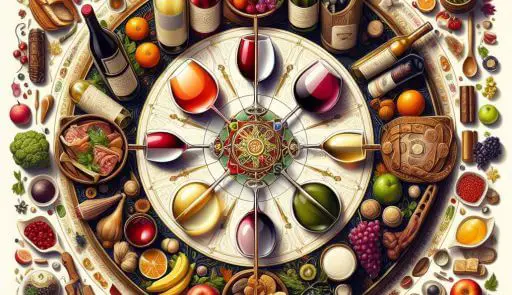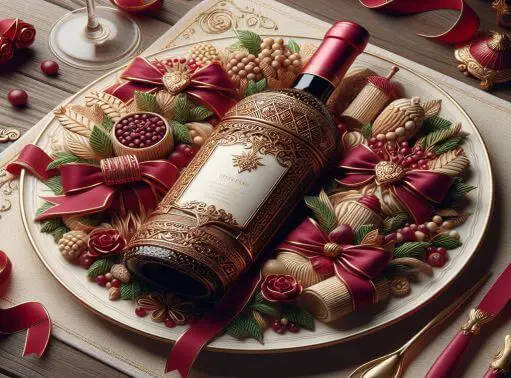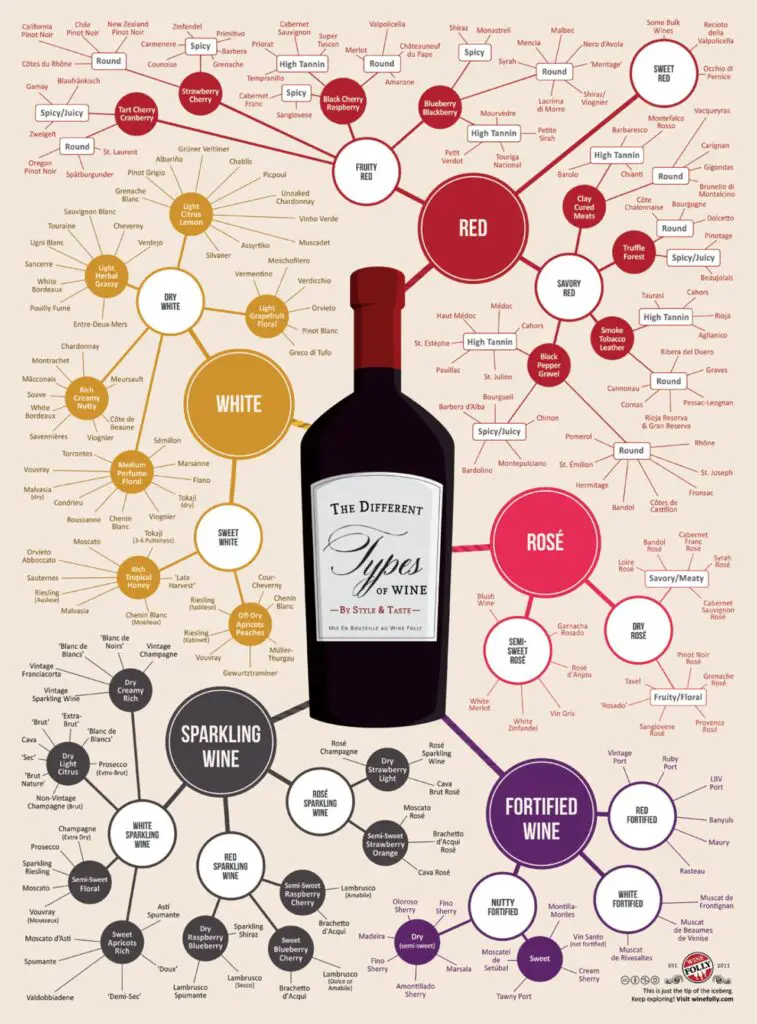Discover the 4 different types of wine and their unique characteristics and find the perfect wine for any occasion.
Wine has been enjoyed by humanity for thousands of years, with its origins dating back to ancient civilizations.
Over time, different regions have perfected the art of winemaking, resulting in a wide variety of wine types, each with its unique characteristics.
While there are countless grape varieties and wine styles, four major types of wine dominate the wine world.
These types include red wine, white wine, rosé wine, and sparkling wine.
In this article, we will clear the confusion surrounding types of wine and explore the characteristics and production methods that distinguish these four major types.
Recommended: Wine Appreciation
Table of Contents
- Popularity and Diversity of Wines
- Importance Of Understanding the Major Types of Wine as a Gentleman
- What are the 4 Types of Wine?
- Most Popular Types of Wine
- Types of Wine Chart
- Frequently Asked Questions
- A Word from Gentsways
Popularity and Diversity of Wines

My dad never really had any wine favourite, there were ones he brought home often, but there are varieties.
With countless varieties and flavours, wine is loved and appreciated by many.
From rich reds to crisp whites, there is a type of wine for every taste bud.
Each type of wine carries its own story, heritage, and taste profile, ensuring there’s a bubbly option for every palate and occasion.
Every gentleman needs to have a basic understanding of the different types of wine.
Popularity and diversity are two key characteristics that define the world of wines.
Wine has gained immense popularity over the years, not only as a beverage but also as a symbol of social status and sophistication.
With its rich history and cultural significance, wine has captivated people from all walks of life.
Related: Guides to Wine Pairing with Salmon
One of the factors contributing to the popularity of wines is their versatility.
From reds to whites, sparkling to fortified, sweet to dry, there is a wine to suit every taste preference.
Different grape varieties, regions, and winemaking techniques further enhance the diversity of wines.
This diversity allows you to explore and discover new flavours and styles, making wine an exciting and ever-evolving experience.
Moreover, wine production is not limited to a specific region or country, but rather spans across the globe.
This transcultural nature of wine exposes consumers to different winemaking traditions, terroirs, and grape varieties, resulting in an unparalleled range of options.
Related: Wine Etiquette
Importance Of Understanding the Major Types of Wine as a Gentleman
Understanding the major types of wine is important for a gentleman as it allows for confident social interactions, adherence to social etiquette, considerate gift-giving, successful business engagements, and personal enjoyment of this timeless beverage.
Let’s take a closer look:
1. Social Gatherings: Knowing about wine enables informed choices, sophisticated conversations, and the ability to select wines for different occasions, showcasing sophistication.
2. Etiquette: Understanding wine allows graceful navigation of social etiquette, confident handling of formal dinners, and thoughtful gift selection for various occasions.
3. Gift-giving: Knowledge of wine enables thoughtful gift selection, aligning with the tastes of recipients and reflecting the uniqueness of events, showcasing attentiveness.
4. Business Relationships: Wine knowledge impresses counterparts, showcases an understanding of entertaining details, and helps in building and nurturing professional relationships over shared interests.
5. Personal Enjoyment: Understanding wine enhances personal enjoyment, allows exploration of different flavours, and helps in developing preferences and refining the palate.
Related: The Different Wine Regions Around the World
What are the 4 Types of Wine?
The four types of wine are:
- Red wine
- White wine
- Rosé wine and
- Sparkling wine
Let’s take a closer look at them one after the other:
Red Wine

Firstly, let’s begin with the red wine. As the name suggests, red wine possesses a deep red color, ranging from ruby hues to opaque dark shades.
The rich colour is derived from the skin of red or black grapes, which is left in contact with the grape juice during fermentation.
This extended contact enriches the wine with tannins, giving it a full-bodied and complex texture.
Red wines can exhibit a wide range of flavours, including red fruits like cherries and berries, as well as more earthy notes like tobacco and leather.
Common red wine varietals include:
- Merlot
- Cabernet Sauvignon
- Pinot Noir and
- Shiraz, among others.
These wines are often aged in oak barrels to enhance their flavors and aromas, offering a deeper and more mature profile.
White Wines

On the other hand, white wine stands in stark contrast to its red counterpart.
White wines are made by fermenting either white grapes or by extracting the clear juice from red grapes and removing the skin before fermentation.
This distinct process results in a wine that ranges in color from pale yellow to golden, lacking the deep color associated with red wines.
White wines tend to be lighter and crisper on the palate, often boasting flavors of citrus fruits, apples, pears, and flowers.
Popular white wine varietals include:
- Chardonnay
- Sauvignon Blanc
- Riesling, and
- Pinot Grigio
White wines are typically served chilled, making them a refreshing choice on hot summer days.
Rosé Wine

The third major type of wine to explore is rosé wine.
Rosé wines bridge the gap between red and white wines, offering a unique and enticing experience.
These wines are produced from red or black grapes, like red wine, but they undergo a shorter period of skin contact during fermentation, resulting in a lighter color.
The range of rosé hues spans from pale pink to vibrant salmon.
Rosé wines are known for their diverse range of flavours, which can include:
- Strawberries
- Cherries
- Melons, and
- Floral notes
These versatile wines are often associated with warm weather and are commonly enjoyed during outdoor events or as an aperitif.
Related: Fundamentals of Wine and Food Pairing
Sparkling Wine

Lastly, sparkling wine adds a touch of glamour and celebration to the wine world.
These wines are noted for their effervescence and are made using different methods, the most famous being the traditional method used to produce Champagne.
Sparkling wines can be either white or rosé, and the bubbles are a result of a second fermentation process that takes place in the bottle, trapping carbon dioxide.
This process leads to the distinct fizziness and lively texture that sparkling wines are known for.
Sparkling wines boast a range of flavours, from crisp citrus notes to creamy bakery flavors.
Examples of sparkling wine include:
- Champagne
- Prosecco, and
- Cava
While these four major types of wine dominate the wine market, it is worth mentioning that there are countless other wine styles, including fortified wines like Port and Sherry, as well as dessert wines like Sauternes and Ice Wine.
Each of these wine styles offers a unique experience, catering to diverse palates and occasions.
Related: Wines that Pair with Lamb
Most Popular Types of Wine

The most popular types of wine cover a diverse range of varietals and styles.
Among red wines, Cabernet Sauvignon and Merlot are widely favoured for their rich, full-bodied profiles.
Chardonnay and Sauvignon Blanc stand out as popular choices in the category of white wines, celebrated for their refreshing and versatile nature.
Additionally, Pinot Noir enjoys widespread popularity for its elegant and nuanced character.
Furthermore, sparkling wines such as Champagne and Prosecco hold a special place, often associated with celebrations and special occasions.
These varieties represent some of the most popular types of wine widely consumed.
Each offers a unique and delightful drinking experience.
Types of Wine Chart

A types of wine chart is a visual tool that depicts the different categories and varieties of wines.
It is typically organized hierarchically, showcasing various types of wines from general categories to specific varieties.
The chart helps wine enthusiasts and consumers understand the diversity and characteristics of different wines.
Here are the typical components of a types of wine chart:
1. General Categories in the Types of Wine Chart
The chart often starts with broad categories such as red wine, white wine, rosé wine, sparkling wine, and fortified wine.
This categorization is based on the color, production method, and flavor profile of the wine.
2. Subcategories
Within each general category, there are further subcategories that represent different styles and characteristics.
For example, red wine subcategories may include light-bodied reds, medium-bodied reds, full-bodied reds, or specific types like Bordeaux, Burgundy, or Rioja.
3. Varietal or Grape-specific Wines
This section focuses on wines made primarily from a single grape variety.
For instance, under the white wine category, there could be subcategories like Chardonnay, Sauvignon Blanc, Riesling, and Pinot Grigio.
Similarly, the red wine section may include Cabernet Sauvignon, Merlot, Pinot Noir, or Syrah.
4. Blended Wines
This part showcases wines that are made by blending different grape varieties.
Blends often have a specific regional or brand name associated with them.
5. Sweetness Level
The chart may include sweetness levels ranging from dry to sweet. It helps wine drinkers identify wines that suit their taste preferences.
6. Production Regions
Some charts include a geographical aspect, highlighting famous wine-producing regions across the globe.
It helps to identify wines by their origins and often provides additional information about the region’s unique characteristics.
7. Flavour Profiles
Depending on the complexity of the chart, it may describe flavour profiles associated with each type of wine.
This information helps wine lovers understand and compare the taste and aroma characteristics specific to different wines.
Frequently Asked Questions
What are the 4 types of wine?
Red, white, rosé, and sparkling are the four main types of wine.
How many types of wine are there?
There are countless types of wine, ranging from popular varietals to unique regional specialties.
Which type of wine is best?
The best type of wine is subjective, depending on personal taste, the occasion, and the food pairing. Experimenting with different varieties can help discover personal preferences.
What are the 3 main classifications for wine?
The three main classifications for wine are table wine, sparkling wine, and fortified wine. These categories covers the majority of wines available worldwide, each with distinct characteristics and production methods.
A Word from Gentsways
The world of wine is a fascinating and complex one, with a vast array of grape varietals, regions, and production methods.
The four major types of wine, red wine, white wine, rosé wine, and sparkling wine, offer a glimpse into this diverse and ever-evolving industry.
Whether it’s the deep, tannin-rich red wines, the crisp and refreshing whites, the versatile and charming rosés, or the celebratory sparkle of a fine bottle of bubbly, there is a wine to suit every taste and occasion.
So, raise a glass and toast to the immense pleasure that wine brings us, as we continue to explore and appreciate this age-old elixir.
References:
- https://www.medicalnewstoday.com/articles/healthiest-wine
- https://www.wsetglobal.com/knowledge-centre/blog/2023/october/03/how-many-wine-types-and-styles-are-there/
- https://www.primermagazine.com/2022/learn/different-wine-types
- https://www.quora.com/What-are-the-different-types-of-wine-and-their-taste-profiles
Pyo Merez is a men’s lifestyle enthusiast and writer about the gentleman’s place and impact on society. Raised by a distinguished gentleman dad, he offers unique insights into how the mind of a gentleman works and how societal norms shape gentlemen’s identity and vice versa.
Through his insightful articles, Pyo taps into the depths of gentleman culture to provide perspectives on etiquette and manners in modern society.

